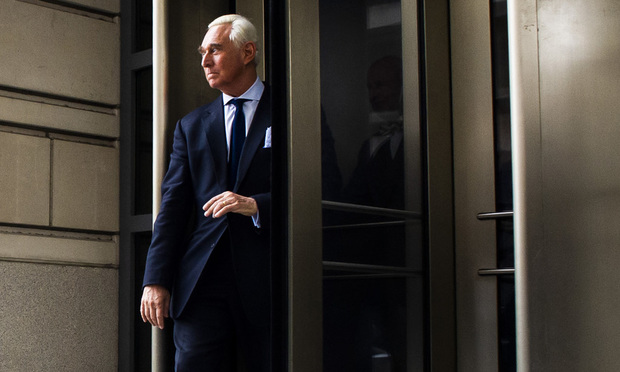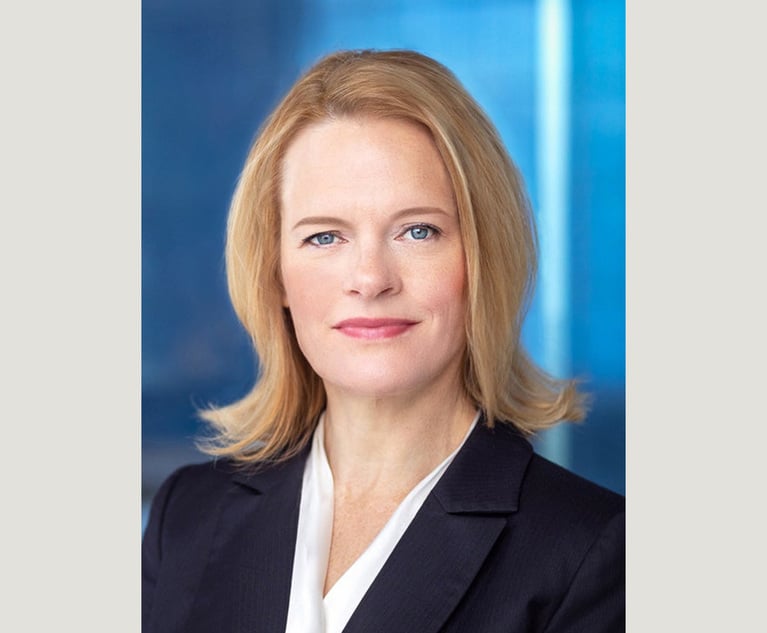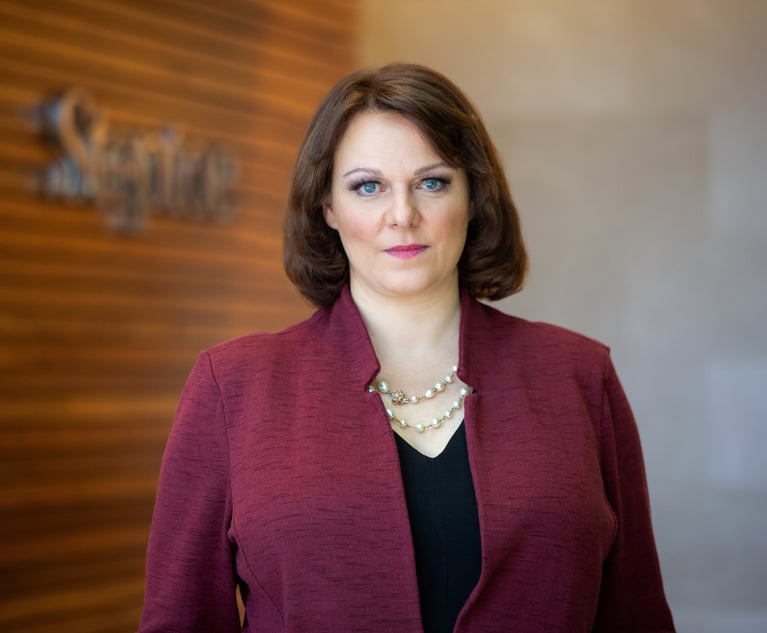Roger Stone Doesn't Want DC Jury to Learn About His Trump Campaign Contacts at Upcoming Trial
The effort to not disclose how often Stone was in touch with the Trump campaign comes after Stone's lawyers invoked their client's relationship with the president as reason to believe he was being selectively prosecuted and that the charges against him should be dismissed.
September 23, 2019 at 07:08 PM
6 minute read
 Roger Stone departs Federal Court after attending his arraignment hearing on Jan. 29, 2019. Credit: Diego M. Radzinschi/ALM
Roger Stone departs Federal Court after attending his arraignment hearing on Jan. 29, 2019. Credit: Diego M. Radzinschi/ALM
Roger Stone hasn't shied away from touting his relationship with President Donald Trump—until now.
Lawyers for Stone, at one time an adviser to the Trump campaign, previously argued in court that he was facing retaliation due to his ties with Trump,
Now Stone is objecting to a jury potentially seeing a chart showing how often he was in touch with the campaign in 2016.
The chart is one of 187 proposed exhibits federal prosecutors want to use during Stone's upcoming November trial, according to a partially redacted filing made Monday.
The Justice Department states in the filing that it wants to show a "chart showing number of written communications between Stone and Trump campaign officials in 2016."
But Stone's attorneys don't want the chart to be shown in court in all. They're raising four different objections to the proposed exhibit, according to Monday's filing: relevance, best evidence, unduly prejudicial and completeness.
Exactly how many Trump campaign officials Stone was in touch with back in 2016 is unclear. Former White House strategist Steve Bannon emailed back and forth with Stone at one point during the campaign, according to emails obtained and published last year by The New York Times.
The indictment against Stone also refers to contacts between him and Trump campaign officials, but does not provide names. However, a document made in Stone's case earlier this month that appeared to have been publicly filed by mistake did include the names of some campaign staffers.
Bannon was named in that document, as was former campaign head Paul Manafort, former campaign official Rick Gates and ex-adviser Sam Nunberg.
It's unclear exactly who will be testifying in Stone's trial, although Gates—who has cooperated with then-special counsel Robert Mueller—may be on deck to appear in court come November. Stone is the only individual charged in the case.
Mueller claimed in the complaint filed against Stone in January that he "maintained regular contact with" the Trump campaign through the 2016 election.
"During the summer of 2016, Stone spoke to senior Trump Campaign officials about Organization 1 and information it might have had that would be damaging to the Clinton Campaign," the indictment states, referring to WikiLeaks as "Organization 1."
"Stone was contacted by senior Trump Campaign officials to inquire about future releases by Organization 1."
The indictment also alleged that a "senior Trump Campaign official was directed to contact Stone about any additional releases and what other damaging information Organization 1 had regarding the Clinton Campaign. Stone thereafter told the Trump Campaign about potential future releases of damaging material by Organization 1."
Stone is charged with making false statements during his testimony before the House Intelligence Committee about his contacts with WikiLeaks, including about his communications with the Trump campaign about WikiLeaks.
The GOP strategist is alleged to have lied during that testimony when he said he never spoke with any Trump campaign members about his contacts with a third party, who in turn was in touch with WikiLeaks.
"Stone spoke to multiple individuals involved in the Trump Campaign about what he claimed to have learned from his intermediary to" WikiLeaks, the indictment reads.
The effort to not disclose how often Stone was in touch with the Trump campaign comes after Stone's lawyers invoked their client's relationship with the president as reason to believe he was being selectively prosecuted and that the charges against him should be dismissed.
But U.S. District Judge Amy Berman Jackson of the District of Columbia, who is presiding over Stone's case, disagreed.
"Based on the allegations in the indictment which are assumed to be true for purposes of these motions, it is fair to say that Roger Stone has no one but himself to blame for the fact that he was investigated by the Department of Justice," Jackson wrote in an opinion issued in August.
Stone's attorneys are objecting to 11 of the exhibits in total, and have "objections reserved" for another.
The vast majority of the exhibits listed in Monday's filing appear to be messages between Stone and other individuals.
The names of the people messaging with Stone are redacted. But Jerome Corsi and Randy Credico, the two men largely referred to throughout Stone's indictment, are likely featured heavily among the redactions.
Stone's attorneys filed their own exhibit list later Monday, including 156 proposed exhibits. The vast majority of those listed Corsi and Credico by name.
Neither man has been charged in the case, although Credico has been subpoenaed to appear in court for Stone's trial.
Stone's legal team are also against the full transcript of Stone's testimony with the House Intelligence Committee, labeling it as "hearsay" and "unduly prejudicial," among other objections.
Their opposition to at least one other proposed exhibit was already known: A clip from "The Godfather Part II."
Federal prosecutors want to show a clip from the movie to explain a reference Stone made in a text to Credico, as he encouraged his then-associate to not testify before the House Intelligence panel.
Stone's lawyers argued in a court filing earlier this month that allowing the jury to view the four-minute clip, showing the fictional mafia member Frank Pentangeli lying to a Senate committee, will cause their client to appear like famed fictional mob boss Michael Corleone.
"It makes Roger Stone the Michael Corleone character in this analogy—an iconic violent godfather of the Mafia," Stone's lawyers wrote in the August filing.
Related stories:
Judge Blames Roger Stone for Roger Stone's Problems, Refuses to Dismiss Charges
Did a Roger Stone Filing Just Reveal a Cellphone Number for President Trump?
Roger Stone's Lawyers Were in Court Today. It Didn't Go Well
This content has been archived. It is available through our partners, LexisNexis® and Bloomberg Law.
To view this content, please continue to their sites.
Not a Lexis Subscriber?
Subscribe Now
Not a Bloomberg Law Subscriber?
Subscribe Now
NOT FOR REPRINT
© 2025 ALM Global, LLC, All Rights Reserved. Request academic re-use from www.copyright.com. All other uses, submit a request to [email protected]. For more information visit Asset & Logo Licensing.
You Might Like
View All

SEC Official Hints at More Restraint With Industry Bars, Less With Wells Meetings
4 minute read

Sidley Adds Ex-DOJ Criminal Division Deputy Leader, Paul Hastings Adds REIT Partner, in Latest DC Hiring
3 minute readTrending Stories
- 1The Importance of Federal Rule of Evidence 502 and Its Impact on Privilege
- 2What’s at Stake in Supreme Court Case Over Religious Charter School?
- 3People in the News—Jan. 30, 2025—Rubin Glickman, Goldberg Segalla
- 4Georgia Republicans Push to Limit Lawsuits. But Would That Keep Insurance Rates From Rising?
- 5Trending Issues in Florida Construction Law That Attorneys Need to Be Aware Of
Who Got The Work
J. Brugh Lower of Gibbons has entered an appearance for industrial equipment supplier Devco Corporation in a pending trademark infringement lawsuit. The suit, accusing the defendant of selling knock-off Graco products, was filed Dec. 18 in New Jersey District Court by Rivkin Radler on behalf of Graco Inc. and Graco Minnesota. The case, assigned to U.S. District Judge Zahid N. Quraishi, is 3:24-cv-11294, Graco Inc. et al v. Devco Corporation.
Who Got The Work
Rebecca Maller-Stein and Kent A. Yalowitz of Arnold & Porter Kaye Scholer have entered their appearances for Hanaco Venture Capital and its executives, Lior Prosor and David Frankel, in a pending securities lawsuit. The action, filed on Dec. 24 in New York Southern District Court by Zell, Aron & Co. on behalf of Goldeneye Advisors, accuses the defendants of negligently and fraudulently managing the plaintiff's $1 million investment. The case, assigned to U.S. District Judge Vernon S. Broderick, is 1:24-cv-09918, Goldeneye Advisors, LLC v. Hanaco Venture Capital, Ltd. et al.
Who Got The Work
Attorneys from A&O Shearman has stepped in as defense counsel for Toronto-Dominion Bank and other defendants in a pending securities class action. The suit, filed Dec. 11 in New York Southern District Court by Bleichmar Fonti & Auld, accuses the defendants of concealing the bank's 'pervasive' deficiencies in regards to its compliance with the Bank Secrecy Act and the quality of its anti-money laundering controls. The case, assigned to U.S. District Judge Arun Subramanian, is 1:24-cv-09445, Gonzalez v. The Toronto-Dominion Bank et al.
Who Got The Work
Crown Castle International, a Pennsylvania company providing shared communications infrastructure, has turned to Luke D. Wolf of Gordon Rees Scully Mansukhani to fend off a pending breach-of-contract lawsuit. The court action, filed Nov. 25 in Michigan Eastern District Court by Hooper Hathaway PC on behalf of The Town Residences LLC, accuses Crown Castle of failing to transfer approximately $30,000 in utility payments from T-Mobile in breach of a roof-top lease and assignment agreement. The case, assigned to U.S. District Judge Susan K. Declercq, is 2:24-cv-13131, The Town Residences LLC v. T-Mobile US, Inc. et al.
Who Got The Work
Wilfred P. Coronato and Daniel M. Schwartz of McCarter & English have stepped in as defense counsel to Electrolux Home Products Inc. in a pending product liability lawsuit. The court action, filed Nov. 26 in New York Eastern District Court by Poulos Lopiccolo PC and Nagel Rice LLP on behalf of David Stern, alleges that the defendant's refrigerators’ drawers and shelving repeatedly break and fall apart within months after purchase. The case, assigned to U.S. District Judge Joan M. Azrack, is 2:24-cv-08204, Stern v. Electrolux Home Products, Inc.
Featured Firms
Law Offices of Gary Martin Hays & Associates, P.C.
(470) 294-1674
Law Offices of Mark E. Salomone
(857) 444-6468
Smith & Hassler
(713) 739-1250








